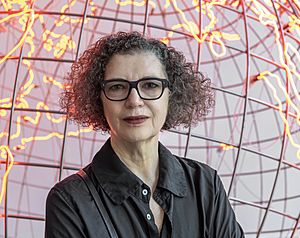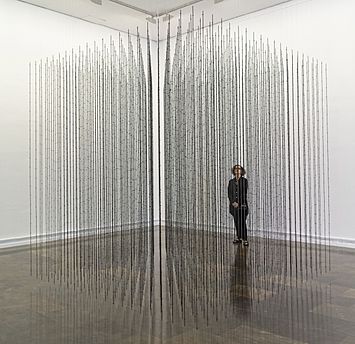Mona Hatoum facts for kids
Quick facts for kids
Mona Hatoum
|
|
|---|---|

Mona Hatoum, 2021, during the closing of her exhibition at IVAM.
|
|
| Born | 1952 (age 72–73) Beirut, Lebanon
|
| Education | Beirut University College |
| Awards | Rolf Schock Prizes in Visual Arts (2008) Joan Miró Prize (2011) Praemium Imperiale (2019) Julio González Prize (2020) |
Mona Hatoum (Arabic: منى حاطوم; born in 1952) is a British-Palestinian artist. She creates art using many different types of media and makes large art pieces called installation art. She lives in London.
Contents
About Mona Hatoum
Mona Hatoum was born in 1952 in Beirut, Lebanon. Her parents were from Palestine. Even though she was born in Lebanon, she could not get a Lebanese identity card. She does not see herself as Lebanese. When she was growing up, her family did not want her to become an artist. But she kept drawing and illustrating her schoolwork.
Hatoum studied graphic design for two years at Beirut University College in Lebanon. After that, she worked at an advertising company. She did not like the advertising work she was doing. In 1975, she visited London. While she was there, the Lebanese Civil War started. This meant she could not go back home and had to stay in London.
She continued her art training in London. She studied at the Byam Shaw School of Art and the Slade School of Fine Art from 1975 to 1981. Since then, she has traveled a lot. She has created art that explores human struggles. These struggles are often about political conflicts, unfairness in the world, and feeling like an outsider.
Mona Hatoum's Art and Ideas
Mona Hatoum explores many different topics in her art. Her work can show ideas about the human body. It can also comment on politics, or on gender and differences. She often looks at the dangers and limits of home life. Her sculptures and installations also use the idea of space. Viewers need to be in the space around her art for it to have its full effect.
Her art often has many meanings. Hatoum wants her art to make people feel things physically. This then causes them to have unique thoughts and feelings. Different people will react to her art in their own ways.
Early Artworks
Hatoum's first artworks were mostly performances. She would directly interact with an audience to make a political point. She used her own body to make strong statements. These performances often talked about her background and the political situation in Palestine. Her art showed how people can be vulnerable. It also showed how powerful systems can be violent. She often used her own body as a main focus.
One example is her 1985 work, Roadworks. In this piece, Hatoum walked barefoot through the streets of Brixton, London. She had black boots tied behind her ankles. This artwork was a comment on how police watched and controlled the mostly Afro-Caribbean community. This happened after the Brixton riots in 1981 and 1985. Hatoum said she felt like she was working "for" the people in Brixton. She felt her art was important to their community. Roadworks was shown in the 2023 Women in Revolt Exhibition at Tate Modern.
Measures of Distance
Measures of Distance was made in 1988. It shows Hatoum's early ideas about family, being forced to leave home, and female identity. This video is fifteen minutes long. It shows close-up, colorful photos of Hatoum's mother showering. Hatoum put letters from her mother over these photos. Her mother was living in Beirut during the civil war. Hatoum was living in London.
The letters were written in Arabic. They are the story and main ideas of the video. They talk about how hard it was to send letters during the war. Hatoum reads the letters aloud in both Arabic and English. The video is based on a short family visit in Beirut in 1981. This was when Hatoum saw her parents again. The video is mainly about the mother-daughter bond. But it also mentions Hatoum's father. So, it looks at the father-daughter and husband-wife relationships too.
The video's parts—the letters, her mother wanting to see her, and mentions of the war—show how the war in Palestine and Lebanon affected her family. It also shows how it changed Hatoum's own identity. The video is not a news report. It questions common ideas about people. It also stays hopeful. The letters are mostly positive, except for the sadness about the distance between mother and daughter. Hatoum tries to show what it was like when she met her mother. She also shows when she asked to photograph her in the shower.
Instead of showing the Israeli–Palestinian conflict or the Lebanese Civil War directly, Hatoum shows how these wars affected her family. She also shows how they affected her identity. Hatoum uses both English and Arabic in her narration. This can make Western audiences feel both close to and far from the story.
In this artwork about a Palestinian woman, Hatoum gives her mother a voice. She also challenges common ideas about Arab women. The Tate Modern says that through Hatoum's art, her mother can show herself freely. This creates a strong bond between them. This bond is separate from outside influences. Measures of Distance is one of the few works by Hatoum that directly talks about her background. In other works, Hatoum likes to be more abstract. She leaves her art open for different ideas. Even though this work is not as abstract, viewers still have to think about how to understand it. The story is not given easily by Hatoum. The video shows the "strange state of being far away geographically but close emotionally." It highlights her feelings of being exiled and separated by war.
Measures of Distance was shown at the London Film Festival, AFI National Video Festival, and the Montreal Women's Film and Video Festival.
Grater Divide
Grater Divide was made in 2002. It takes an everyday kitchen grater and makes it huge. It becomes a divider that is about 80 inches tall. This artwork hints at political separation. It might refer to the walls built by Israel in Palestinian areas.
Hot Spot III
Hot Spot III, created in 2009, is a large art piece. It is a globe tilted like the Earth and is about as tall as a person. The title connects to the idea of political problems. It suggests that conflict in one part of the world can affect everyone. The globe is made of steel that looks like a cage. It glows bright red, as if the world is on fire. The light flickers quickly. This creates an exciting feeling that draws the audience in. The hot red light outlining the continents also makes people feel a sense of danger. Hatoum makes us wonder if simple or dream-like art forms can truly deal with the world's big issues.
Later Artworks

In the late 1980s, Hatoum stopped doing performances. She felt they were too direct politically. Instead, she started making installations and objects. She used some ideas from her student days at the Slade School of Art in London. From then on, she wanted viewers to interact with her art. This way, the artist herself was not the main focus.
Since the 1990s, her art has changed from making statements to asking questions. Viewers need to think and interact more with her sculptures and installations. Her art has also started to be made for specific places. Examples include the Institute of Contemporary Art, Boston and Kunsthalle Hamburg.
A well-known piece showing her shift from performance to objects is Keffieh (1993–1999). This is a scarf woven from human hair. It combines ideas about being a woman and religion.
At the end of the 1980s, she began to focus on common household items. These included kitchen tools and furniture. T42 (1993–98) is an artwork of two teacups joined together at their rims.
The Body in Art
Many of Hatoum's early artworks focus on the body. They connect the body to ideas about politics, women's rights, and language. This often makes viewers feel a strong physical reaction. One of her pieces, a 1994 video installation called Corps etranger, showed colorful video images. These images were taken from inside her body using a special camera. Corps etranger was first made for Centre Georges Pompidou. It has a partly enclosed, round structure that viewers can enter. The viewer stands on a circular glass plate. They see close-up video images of the artist's body, both inside and out. The artist invites the viewer to "walk around" inside her body. This happens through the video that scans her digestive system. The sound is a recording of a heartbeat and body movements.
Hatoum's art also looks at the idea of 'abjection' (things that are disturbing or rejected). This idea was introduced by a thinker named Julia Kristeva. Hatoum also explores the 'uncanny' (something familiar but also strange) in her works that use body hair.
Art and Politics
The way Hatoum's art uses strange or unsettling images can be linked to politics. The way her art creates a feeling of unease can have big effects. It can relate to power, politics, or personal worries. Her art does not always refer to big political events. It also does not always appeal to a general cultural understanding. Instead, it often points to a hidden threat that can only be dealt with by individuals.
Hatoum has connected her works to other political movements. This includes the struggle for Black rights. In a 1997 interview, Hatoum said that it was important to see the Black struggle as a total political fight. She said there are common political forces that treat people unfairly. She compared it to how feminism started with a big idea of "sisterhood." Then it became many different types of feminism. The Black struggle also became more varied once the main issues were clear. She explained that "blackness" in this context is not about skin color. It is about taking a political stand.
Exhibitions
Hatoum's art was shown in a solo exhibition at the Institute of Contemporary Art, Boston in 2015. In May 2016, Tate Modern held a large show. It explored 35 years of Hatoum's work in Britain. This included her early performances and videos, as well as her sculptures and big installations. The Menil Collection in Houston, Texas, had a solo exhibition called "Mona Hatoum: Terra Infirma." It was open from October 12, 2017, to February 25, 2018. This exhibition then traveled to the Pulitzer Arts Foundation. It was on view there from April 6 to August 11, 2018.
In March 2018, Hatoum was chosen as a finalist for the Hepworth Prize for Sculpture. Other artists chosen were Michael Dean, Phillip Lai, Magali Reus, and Cerith Wyn Evans. In January 2020, Hatoum was part of Artpace’s exhibit called Visibilities: Intrepid Women of Artpace. Also in 2020, she received the Julio González award. This led to a solo exhibition at Institut Valencià d'Art Modern in 2021.
Awards
- 2008 – Rolf Schock Prize in Visual Arts
- 2011 – Joan Miró Prize, Fundació Joan Miró
- 2017 – 10th Hiroshima Art Prize, Hiroshima City Museum of Contemporary Art, Hiroshima
- 2018 – Whitechapel Gallery Art Icon
- 2019 – Praemium Imperiale for sculpture. This award recognized her achievements in sculpture throughout her life.
- 2021 – Julio González Price 2020
See also
 In Spanish: Mona Hatoum para niños
In Spanish: Mona Hatoum para niños
- Palestinian art


